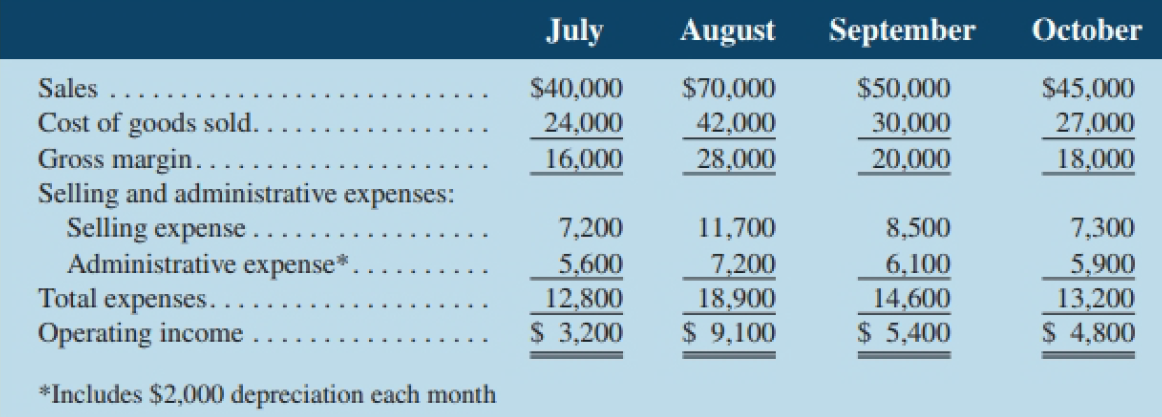Refer to the data for Scott Products Inc. in Problem 9-21. The company's president is interested in
Question:
Refer to the data for Scott Products Inc. in Problem 9-21. The company's president is interested in knowing how reducing inventory levels and collecting accounts receivable sooner will impact the cash budget. He revises the cash collection and ending inventory assumptions as follows:
1. Sales continue to be 20% for cash and 80% on credit. However, credit sales from July, August, and
September are collected over a three-month period, with 25% collected in the month of sale, 60% collected in the month following sale, and 15% in the second month following sale. Credit sales from May and June are collected during the third quarter using the collection percentages specified in Problem 9-21.
2. The company maintains its ending inventory levels for July, August, and September at 25% of the cost of merchandise to be sold in the following month. The merchandise inventory at June 30 remains $18,000 and accounts payable for inventory purchases at June 30 remains $11,700. All other information from Problem 9-21 that is not referred to above remains the same.
Required:
1. Using the president's new assumptions in (1) above, prepare a schedule of expected cash collections for July, August, and September and for the quarter in total.
2. Using the president's new assumptions in (2) above, prepare the following for merchandise inventory:
a. A merchandise purchases budget for July, August, and September.
b. A schedule of expected cash disbursements for merchandise purchases for July, August, and September and for the quarter in total.
3. Using the president's new assumptions, prepare a cash budget for July, August, and September and for the quarter in total.
4. Briefly explain how the president's revised assumptions affect the cash budget.
Data from Prob 9-21
Scott Products Inc. is a merchandising company that sells binders, paper, and other school supplies. The company is planning its cash needs for the third quarter. In the past, Scott Products has had to borrow money during the third quarter to support peak sales of back-to-school materials, which occur during August. The following information has been assembled to assist in preparing a cash budget for the quarter:
a. Budgeted monthly absorption costing income statements for July through October are as follows:

b. Sales are 20% for cash and 80% on credit.
c. Credit sales are collected over a three-month period, with 10% collected in die month of sale, 70% in the month following sale, and 20% in the second month following sale. May sales totalled $30,000, and June sales totalled $36,000.
d. Inventory purchases are paid for within 15 days. Therefore, 50% of a month's inventory purchases is paid for in the month of purchase. The remaining 50% is paid in the following month. Accounts payable for inventory purchases at June 30 total $11,700.
e. The company maintains its ending inventory levels at 75% of the cost of the merchandise to be sold in the following month. The merchandise inventory at June 30 is $18,000.
f. Land costing $4,500 will be purchased in July.
g. Dividends of $1,000 will be declared and paid in September.
h. The cash balance on June 30 is $8,000; the company must maintain a cash balance of at least this amount at the end of each month.
i. The company has an agreement with a local bank that allows the company to borrow up to a total loan balance of $40,000. The interest rate on these loans is 1% per month. All borrowing is done at the beginning of a month. The company would, as far as it is able, repay the loan at the end of each month. Interest must be paid at the end of each month based on the outstanding loans for that month. There are no loans outstanding as at June 30.
Ending InventoryThe ending inventory is the amount of inventory that a business is required to present on its balance sheet. It can be calculated using the ending inventory formula Ending Inventory Formula =... Accounts Payable
Accounts payable (AP) are bills to be paid as part of the normal course of business.This is a standard accounting term, one of the most common liabilities, which normally appears in the balance sheet listing of liabilities. Businesses receive... Accounts Receivable
Accounts receivables are debts owed to your company, usually from sales on credit. Accounts receivable is business asset, the sum of the money owed to you by customers who haven’t paid.The standard procedure in business-to-business sales is that... Cash Budget
A cash budget is an estimation of the cash flows for a business over a specific period of time. These cash inflows and outflows include revenues collected, expenses paid, and loans receipts and payment. Its primary purpose is to provide the...
Step by Step Answer:

Managerial Accounting
ISBN: 9781259275814
11th Canadian Edition
Authors: Ray H Garrison, Alan Webb, Theresa Libby





